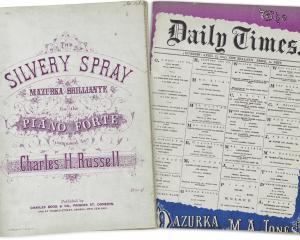
The cloth is hung as a feature drape in the intimate space of the card room, which adjoins the billiard room.

There were regional variations, with the Olveston piece likely to be from the Samarkand-Bukhara area. During the high period of the art - from around 1750 to 1875 - suzanis were prestige items and were usually bedcovers, up to 3m x 2m in size. As the Olveston example is smaller than this, it would have been used as a hanging and more correctly called a ``borpush''. It is a quality item, the profusion of flowers on it referencing the importance of the Gardens of Paradise in Islam, and the art of the garden in this region. The flowers depicted represent indigenous flora.
First, a skilled local designer drew the stylised poppies and carnations, intertwined with leaf shapes and arabesques, on hand-woven cotton strips. These were then embroidered in coloured silk yarns by the bride and her female relatives. The most common stitch used was a laid and couched stitch, in which decorative thread laid on the fabric as a raised line was stitched in place with a second thread, along with double button-hole stitch for outlining. Finally, the panels were joined to make the final piece. Natural dyes came from pomegranate, madder root, onion, saffron and walnut.
Most of the best-preserved suzanis made before 1850 were taken south, away from Russian expansion into central Asia, then passed through generations of families that once lived in India, with the result that many fine suzanis are in British private collections.
The ancient folklore of central Asia has now mostly disappeared, due to industrialisation and years of Russian dominance. We are lucky to have this beautiful textile in Dunedin.
Jenny Longstaff is an Olveston tour guide and educator.

![‘‘Neil’s Dandelion Coffee’’. [1910s-1930s?]. EPH-0179-HD-A/167, EPHEMERA COLLECTION, HOCKEN...](https://www.odt.co.nz/sites/default/files/styles/odt_landscape_small_related_stories/public/slideshow/node-3436487/2025/09/neils_dandelion_coffee.jpg?itok=fL42xLQ3)










